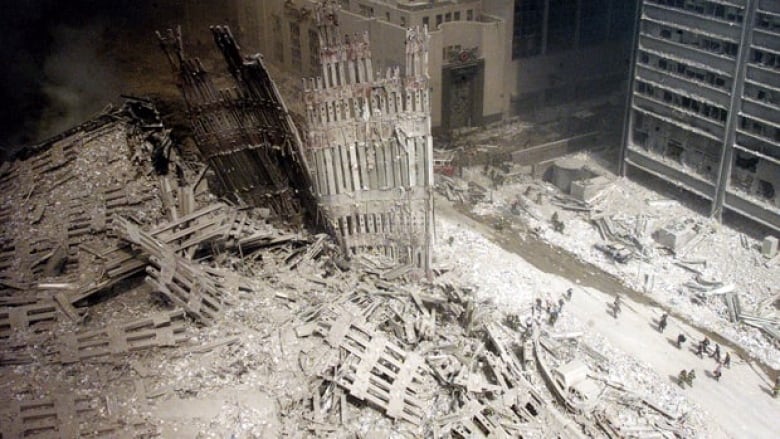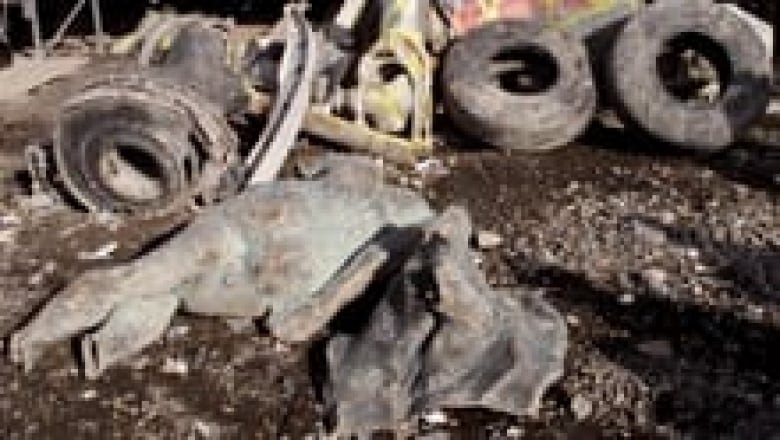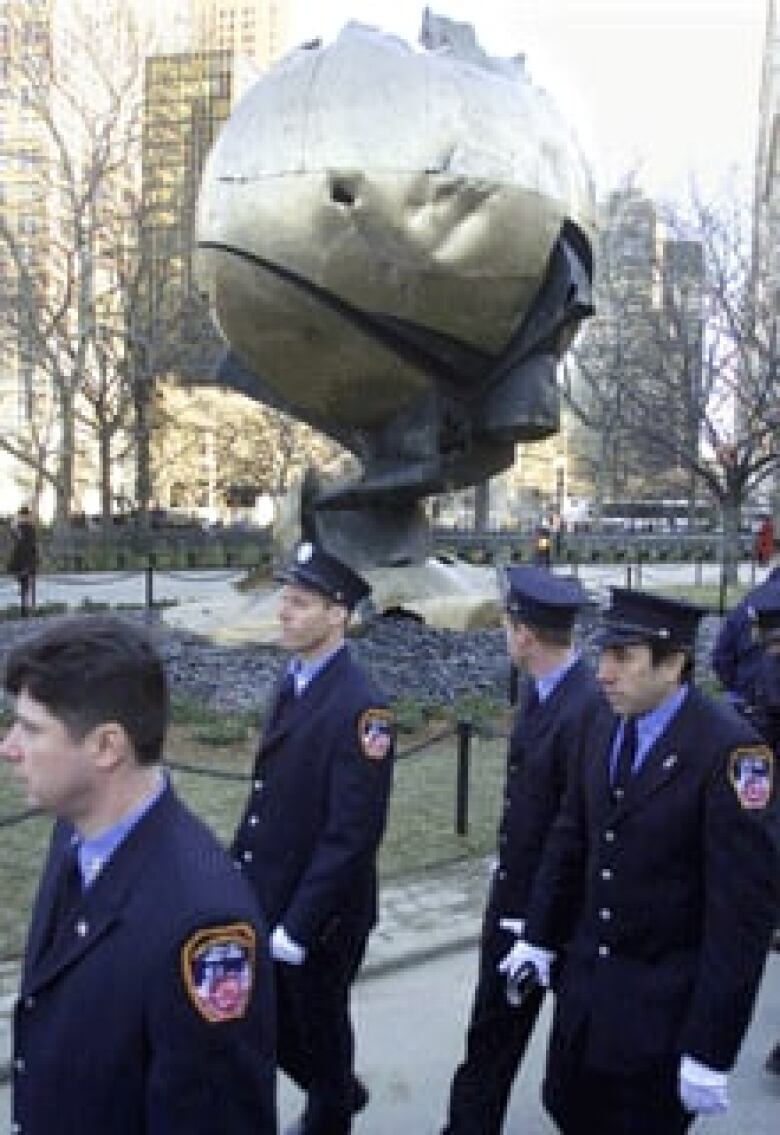9/11 anniversary: What was lost in the damage
Irreplaceable documents, art, artifacts destroyed along with nearly 3,000 lives

In New York, 6.5 hectares of buildings were directly affected when the Twin Towers collapsed. The entire seven-building complex, which included the offices of more than 400 companies and several federal, state and local government agencies, was destroyed. The 13 million square feet of "Class A" office space (a designation used by realtors and builders to describe the highest quality, most desirable buildings) destroyed is equal to the entire office-space inventory of Atlanta or Miami.
In 2002, the comptroller of the City of New York estimated the impact of the WTC attacks on the city's wealth to be $30.5 billion US, including the cost of lost buildings, infrastructure, tenant assets and the estimated value of the future earnings of those who died.

In the weeks andmonths after the attacks,archivists and librarians metto try to get an idea of what was lost. The Heritage Emergency National Task Force, made up of representatives of 34 federal agencies and national associations, sent out a survey to 122 museums, libraries, archives and exhibit spaces located south of 14th Street in Lower Manhattan and at the Pentagon in an attempt to assess the damage but fewer than half of them responded.Based on the survey and extensive follow-upinterviews, the task force publisheda 26-page report called Cataclysm and Challenge outlining some of the cultural items lost.
The full extent of what was lost in the disaster will likely never be known. Archival authorities admitted that althoughall federal agencies are required to report destruction of records to the U.S. National Archives and Records Administration, in the aftermath of 9/11, most neglected to do so in the faceof more pressing priorities such as coming to grips with the deaths ofcolleagues and the challenge of rebuilding their infrastructure. In many cases, the record of what items companies andinstitutions had in their collections and files was lost alongwith the items themselves.
Below are some of the items and facilities destroyed or damaged in the disaster:
- 21 libraries inside the World Trade Center, including that of the Journal of Commerce.
- Records belonging to the Securities and Exchange Commission. Reuters news agency and the Los Angeles Times reported that files in 3,000 to 4,000 active cases were lost, including ones relating tothe agency's investigation intoinvestment banks' divvying up of hot sharesof initial public offerings during the high-tech boom of the 1990s.
- Files belonging to the Central Intelligence Agency, whichhad asecret office on the 25th floor of 7 World Trade Center,andthe U.S. Secret Service, which based more than 200 agents at itsoffices in the same building. The 7 World Trade Center building was north of the main towers and was not directly hit in the attack but collapsed later in the afternoon of Sept. 11, 2001. In the days after the attacks, CIA and Secret Service staff sifted through debris that had been carted to a Staten Island landfill looking for lost documents, hard drives with classified information and intelligence reports.
- Active case files of the Equal Employment Opportunity Commission, which investigates discrimination cases. The office said it lost documentsin about 45 active case files that could not be easily retrieved, including ones relating to a sexual harassment case against Morgan Stanley, whose offices werealso destroyed in the attacks. The records loss delayed some court cases.
- U.S. trade documents dating backto the 1840s that were housed in the library of the U.S. Customs Service in 6 World Trade Center.
- The offices of the emergency operations command centre for the City of New York. Former mayor Rudy Giuliani and city officials were criticized fortheir decision to house the centre at7 World Trade Center even though at the time it was opened in 1999, the WTC site had already once been targeted, in the 1993 bombing that killedsix people.

- Numerous art works in the private collections of businesses and agencies that had offices in the WTC as well as several pieces of public artcommissioned by the Port Authority over the years and displayed throughout the complex. Works lost include WTC Stabile, a red steel sculpture by the late U.S. artist Alexander Calder also known as the Bent Propeller that stood in the WTC courtyard; a large tapestry by Spanish artist Joan Miro that hung in the lobby of 2 World Trade Center; paintingsby Pablo Picasso, David Hockney and Roy Lichtenstein; works by Paul Klee and Le Corbusier in the Marriott Hotel's collection; and Auguste Rodin drawings and sculptures owned by the Cantor Fitzgerald brokerage firm, which lost 650 employees in the disaster and whose late founder was a renowned Rodin collector. Parts of the Calder sculpture were recovered but not enough to fully restore the work. A cast of Rodin's The Thinker reportedly resurfaced shortly afterSept. 11 but disappeared again; some believe it was stolen from Ground Zero.The value ofart lost was estimated at $100 million from private collections and $10 million in public art.
- Studios, equipmentand art worksin the spaces occupied by the Lower Manhattan Cultural Council in 5 World Trade Center.
- The offices and archives of Helen Keller International, the agency founded by deaf and blind activist Helen Keller. Among the documents lost were letters written by Keller. Only a bust of Keller and one book were recovered.
- Thousands of negatives of photos taken by John F. Kennedy's personal photographer, Jacques Lowe, which had been stored in asafe depositvault at 5 World Trade Center.

- The archives and library of the Port Authority of New York and New Jersey, which owns the region's airports, bridges and the World Trade Center. A spokesman for the organization said it only had a "general idea" of what documents were destroyed but one document that is known to have beenlost is the 1921 agreement that created the Port Authority.
- Artifacts from the 19th-century Lower Manhattan neighbourhood of Five Points. About 900,000 objects excavated from an archeologicalsite uncovered in 1991 a few blocks east of the WTC were stored in a room atthe 6 World Trade Center building that was destroyed by the collapse of the north tower. Artifactsfrom an 18th-century burial ground for free and enslaved Africans that were stored in an adjacent room were saved from among the debris.
- Case files from the office of the U.S. Attorney of the Southern District of New York.
- Photographs from the Broadway Theatre Archives.
- Family records and heirlooms stored in safety deposit boxes and vaults of World Trade Center banks, including a collection of 25 antique hand-woven rugs valued at more tha $500,000 US that had been passed down through generations of Muslim families from the Middle East, North Africa and Southeast Asia.
- Materials in the Pentagon library, which housed 500,000 books, documents and historical materials and was hit by the nose of the plane that crashed into the building, were damaged but the bulk of them was restored.
- Twenty-fourworks in the art collections of the army, navy, air force and marine corps at the Pentagon.
The Sphere for Plaza Fountain, a large rotating metal sculpture by German artist Fritz Koenig that was one of the most recognizable works of public art at the World Trade Center, was the only public art work thereto survive. The damaged piece was moved to Battery Park and displayed in its dented state as part of a memorial to the victims of the attacks.












_(720p).jpg)


 OFFICIAL HD MUSIC VIDEO.jpg)
.jpg)



























































































